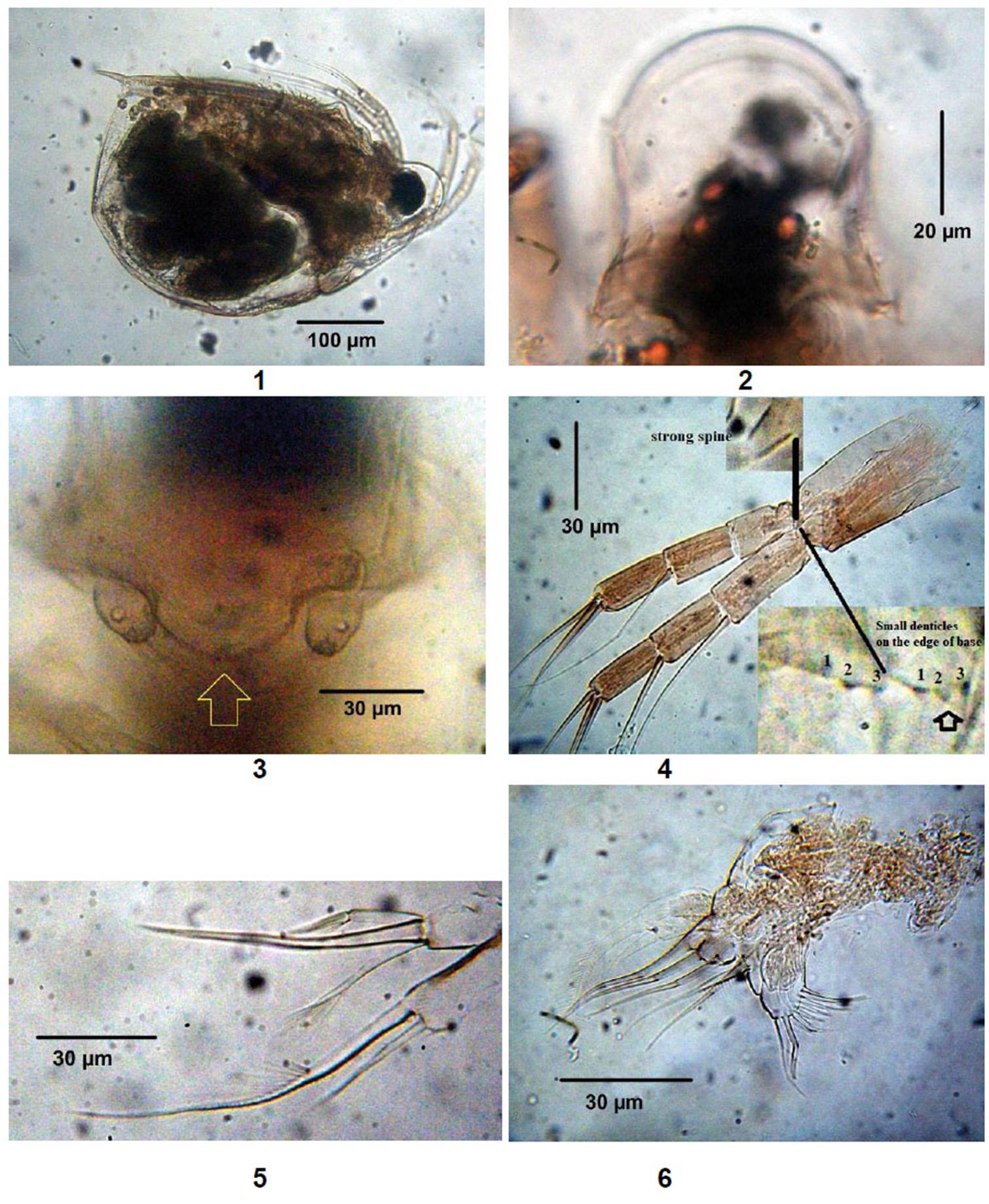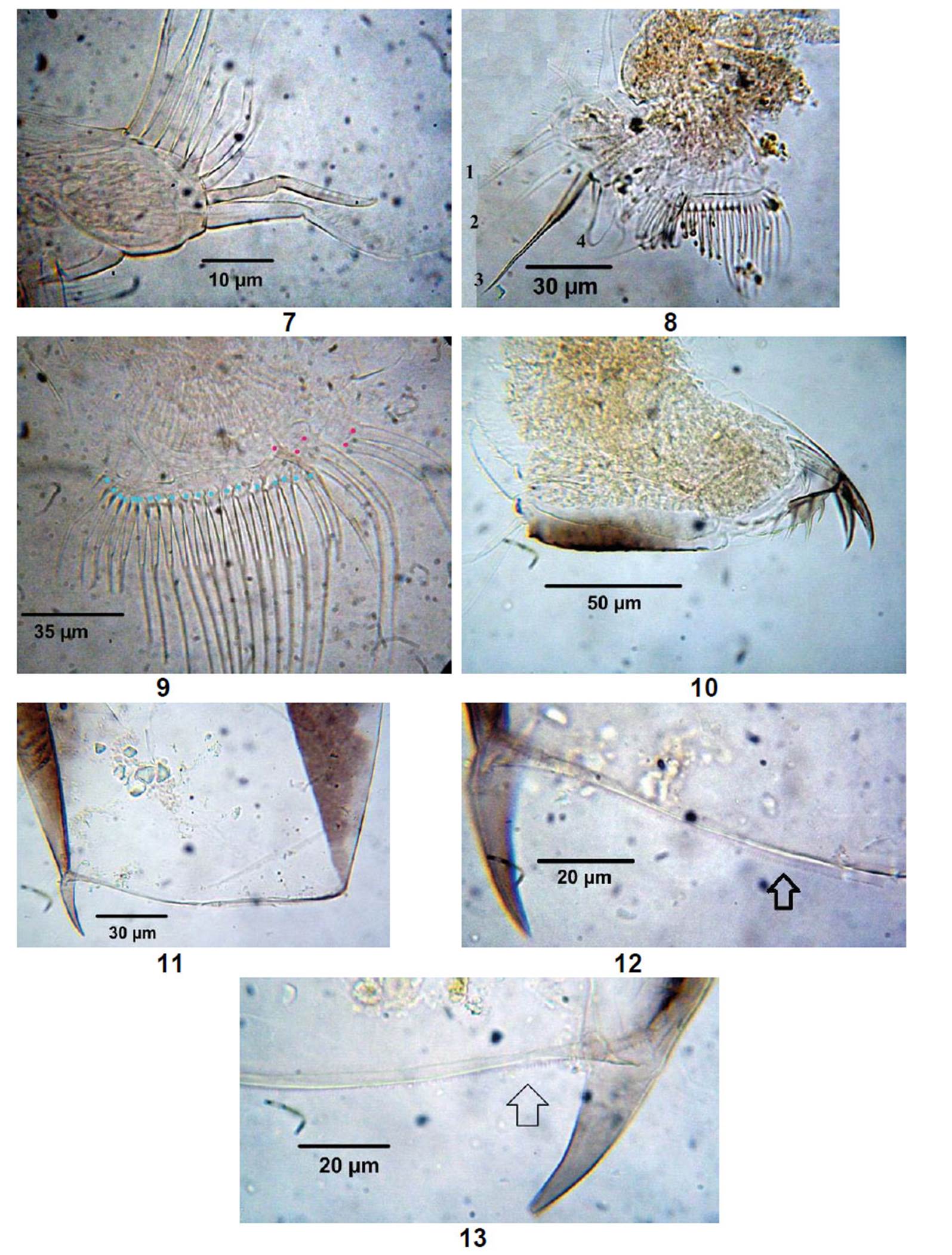The members of the genus Scapholeberis are considered hyponeustonic (Taylor et al. 2020) and most of them have been recorded in the Palaearctic and Neartic region (Kotov et al. 2013). This genus is comprised by ten species: S. mucronata (O. F. Müller, 1776), S. spinifera (Nicolet, 1849), S. armata Herrick, 1882; S. kingii Sars, 1888, S. microcephala Sars, 1890, S. erinaceus Daday, 1903, S. freyi Dumont and Pensaert, 1983, S. rammneri Dumont and Pensaert, 1983, S. duranguensis Quiroz-Vázquez and Elias-Gutiérrez, 2009, and S. yahuarcaquensis, Andrade-Sossa, Buitron-Caicedo and Elias-Gutiérrez, 2020, (Quiroz-Vázquez & Elias-Gutiérrez 2009, Andrade-Sossa, et al. 2020). Of these, S. spinifera, S. rammneri, S. freyi, and S. yahuarcaquensis have good evidence to occur in the Neotropical region (Dumont and Pensaert 1983; Taylor et al. 2020, Andrade-Sossa et al. 2020), while the presumed records of S armata, S. kingi and S. mucrontata are dubious since the former species has distribution Nearctic and the two latter are distributed in the Palearctic region (Dumont & Pensaert 1983). Besides, S. kingii reported in the Neotropic could also have been confused with S. rammneri since this species is confirmed to appear in this region (Taylor et al. 2020). Diversity of Scapholeberis in Neotropical region have been poorly sampled and probably more species of this genus could be found. The study of composition and distribution of the genus Scapholeberis in Colombia is still limited. Hitherto only three species have been recorded in Colombia: S. yahuarcaquensis, S. armata and S. mucronata, (Kotov & Fuentes-Reinés 2015, AndradeSossa et al. 2020).
The aim of this paper is to report on the first record of Scapholeberis freyi for Colombia, which expands this species’ known distributional range in South America, and also to present a brief description of the specimens from this country and South America.
The samples were taken from a small shallow temporary pond located in La Guajira northern Colombia (11°24’33.19" N and 73°03’46.30"W). The sampling water was collected in November 2019 in the littoral areas with vegetation using a bucket of 25 L. Samples were filtered with a zooplankton net (45 μm) to obtain a concentrates a 100 ml and preserved in 70% ethanol with previous addition of a narcotic-like carbon dioxide of soda. The specimens were dissected and the taxonomically relevant appendages were mounted in semi-permanent slides and sealed with Canada balsam. The mounted appendages were photographed using a Kodak Easy Share C140 digital camera adapted to a compound microscope. Specimens were measured in lateral position, from head to the posterior part of the valve. Identifications were according to Dumont and Pensaert (1983) and ElmoorLoureiro (2000).
The voucher specimens were deposited at Museo de Colecciones Biológicas de la Universidad del Magdalena, Colombia (CBUMAG:MEI:0824).
The analyzed specimens (five adult females) fully agreed with the descriptions of Dumont and Pensaert (1983) and Elmoor-Loureiro (2000). Scapholeberis freyi was originally described as S. armata freyi by Dumont and Pensaert (1983), nevertheless this subspecies has been considered as independent species (Kotov et al. 2013, and Taylor et al. 2020). In this manuscript, we also identified S. freyi as independent species, instead of subspecies. In America this species has been previously recorded in Canada, United State of America, Mexico, Paraguay, and Brazil (Dumont & Pensaert 1983, QuirozVázquez & Elias-Gutiérrez 2009, Almeida Castilho et al. 2012). This is the first report for Colombia expanding the occurrence of S. freyi in South America.
General shape oval (Figure 1), rostrum trilobate (Figure 1), with the middle lobe well developed and curved (Figure 1), first antenna short (Figure 1), second antenna with setal formula: 1-1-3/0-0-1-3, basipodite thick with a strong spine in the middle and small denticules on the anterior border (Figure 1), IDL and ODL of limb I with three and two setae (Figure 1), exopod of trunk limb II with 2 feather-like setae, endopod with five apical setae similar in size (Figure 1) and gnathobase with nine setae (Figure 1, Figure 7), exopod of trunk limb III with four apical setae, the third one chitinized and two lateral setae (Figure 7), gnathobase with 19 setae (Figure 7), postabdomen robust, with four large spines in the distal portion (Figure 7), length ratio of the mucro/length of posterior rim of the valve about 1/6 ‒ 1/9 (Figure 7), denticulate membrane at the posterior rim of the valves very fine o inconspicuous (Figure 7), presence membrane hyaline at the posterior riim of valve (Figure 7).
In America this species can be easily confused with its congeners S. yahuarcaquensis, S. armata, and S. duranguensis , but they can be separated by: 1) length ratio of the mucro/length of posterior rim of the valve about 1/6 ‒ 1/9 in S. freyi (Dumont & Pensaert 1983, fig XX:10, Elmoor-Loureiro 2000, figs 2-3, present data, fig. 11) vs. 1/5 ‒ 1/9 in S. armata (Dumont & Pensaert 1983, fig XVIII:5), and 1/4-1/6 in S. duranguensis (Quiroz-Vázquez & Elias-Gutierrez 2009, fig. 3A), and S. yahuarcaquensis (Andrade-Sossa et al. 2020, fig. 1A), 2) presence of hyaline membrane at the posterior rim of valve in S. freyi (Dumont & Pensaert 1983, fig XX:9, 10, present data, figs. 12‒13), S. yahuarcaquensis (Andrade-Sossa et al. 2020, fig 2C) and S. duranguensis (Quiroz-Vázquez & Elias 2009) while it is absent in S. armata (Quiroz-Vázquez & Elias-Gutiérrez 2009); 3) presence of inconspicuous denticulate membrane at the posterior rim of the valves in S. freyi (Dumont & Pensaert 1983, fig XX:9, 10, ElmoorLoureiro 2000, fig 6, present data, figures 12-13) and S. yahuarcaquensis (Andrade-Sossa et al. 2020, fig 2C) vs. conspicuous denticulate membrane in S. armata (Dumont & Pensaert 1983, XVIII:7,13) and S. duranguensis (Quiroz-Vázquez & Elias-Gutierrez 2009), 4) gnatobase of limb II with nine setae in S. freyi (Quiroz-Vázquez & Elias 2009, fig. 4D, present data, figs. 6-7) and S. yahuarcaquensis (Andrade-Sossa et al. 2020, fig 7B) vs. eight setae in S. duranguensis (Quiroz-Vázquez & Elias 2009, fig. 4C) and S. armata (Dumont & Pensaert 1983, fig. XVIII:4), 5) gnatobase of limb III with 19 setae in S. freyi (present data, fig 9) vs. 18 in S. yahuarcaquensis (Andrade-Sossa et al. 2020), 22 setae in A. armata (Dumont & Pensaert 1983) and about 24 setae in S. duranguensis (Quiroz-Vázquez & Elias-Gutiérrez 2009).
Scapholeberis freyi can be easily recognized by its important diagnostic characters such us: 1) rostrum trilobate; 2) inconspicuous or fine denticulate membrane at the posterior rim of the valves; 3) length ratio of the mucro/length of posterior rim of the valve about 1/6 ‒ 1/9; 4) presence membrane hyaline at the posterior rim of valve. These distinctive traits are also characteristic for the specimen from Colombia. Nevertheless some subtle difference was observed in our specimens, 1) the middle lobe of the rostrum is more curved and pronounced vs less curved and pronounced S. freyi reported by Dumont and Pensaert (1983, fig. XX-3), 2) the third apical setae on exopod of trunk limb III chitinized vs. not chitinized in specimens registered by Dumont and Pensaert (1983). However, we do no regard such differences as signs of a separate status of the Colombia population. Unfortunately S. freyi is not fully described and some structures could not be compared for example the number of the setae on gnatobase of trunk limb III, therefore, further studies and molecular analysis is needed.
Total length observed ranged from 518 ‒ 630 µm (mean = 577 µm), being the ovigers female the larger of all (630 µm).
The Colombian populations of S. freyi show an early sexual maturity since this species become reproductive at about 800 µm (Dumont & Pensaert 1983), similar results were reported by Elmoor-Loureiro (2000).

Figure 1-6. Scapholeberis freyi, parthenogenetic female from a temporary pond to northern Colombia. 1. Adult. 2. Rostrum. 3. Idem, middle lobe. 4. Antenna I. 5. IDL and ODL of Limb I. 6. Limb II.

Figure 7-13. Scapholeberis freyi, parthenogenetic female from a temporary pond to northern Colombia. 7. Ganotabase of limb. II. 8. Limb III. 9. Ganotabase of limb III (the blue spot points at the ganotabase setae and the pink one the endites). 10. Postabdomen. 11-13. Posterior rim of the valve (the arrows point at inconspicuous denticulate membrane)












 uBio
uBio 


